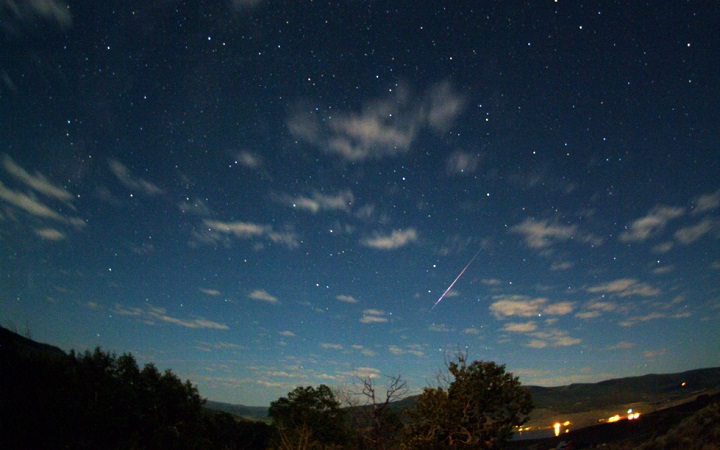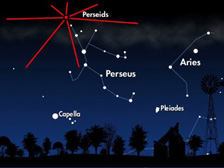
A perseid meteor streaks across a star-encrusted and cloud-scattered sky. Image Credit: Jimmy Westlake
From Ken’s Mingo Perseid Meteor Shower Email Blast*:
“Come join the Amateur Astronomers Association of Pittsburgh observe Perseid meteors, no experience necessary. Just bring a lawn chair, a chaise lounge or a blanket to lie on the grass to observe meteors streaking through the night sky at one of the better meteor showers of the year. Experienced members of the AAAP will be present to explain the sky. We will be on site from 9 PM until the sky begins to brighten for the morning sunrise. Families are welcome. The moon will not interfere with the meteors and at this time, the long-term weather forecast looks promising for that night. It’s recommended that you bring something warm to wear to ward off the night chill, some coffee, other drinks or snacks might help keep you awake. Alcoholic beverages and smoking are not permitted on observatory grounds.”
* Mingo Observatory Email Blast
Would you like to receive occasional emails about Mingo Observatory Star Parties and Observing Events? Be sure to sign up at the Mingo Observatory Reception Desk or contact MingoAssocDirector2(AT)3ap.org.
~~~~~~~~~~~~~~~~~~~~~~~~~~~~~~~~~~~~~~~
Mingo Observatory will open to the public for Perseid Meteor Viewing at 9:00 PM on the night of Wednesday, August 12, into the morning of Thursday, August 13, 2015. Address: 1 Shelter 10 Road Finleyville, PA 15332. Located within Mingo Creek County Park, Washington County, at Henry Covered Bridge, go up Mansion Hill Rd., pass Shelter10 to the right, up the Hill to the observatory at the top of the hill. Mingo Observatory Phone: 724-348-6150 . Mingo Park Map. Latitude 40.211 degrees Longitude -80.020 degrees. When programming your GPS, longitude and latitude are suggested rather than the address. Event is scheduled Condtions Permitting but the long range wether forecast looks Good. There is no fee for this event, but your donations are gladly accepted at the reception desk to support this and similar events. AAAP is a 501(c)(3) and contributions are tax deductible.
AAAP will also hold Perseid Meteor Viewing at Wagman Observatory in Deer Lakes Park, Allegheny County. More on Wagman Perseid Viewing: https://3ap.org/2015/08/wagman-observa…meteor-viewing/
~~~~~~~~~~~~~~~~~~~~~~~~~~~~~~~~~~~~~~~
Some Background:
Meteors are best viewed with the naked eyes and the telescopes will not be the “focus” this meteor viewing event. As staffing and conditions permit there may be some telescope viewing and or planetarium programming, but the real show is in the sky outside of the observatory building.
The annual August Perseid meteor shower ranks as the favorite meteor shower of the year peaking on August 12-13, 2015, with high rates for several nights on either side of the peak. On a dark, moonless night, you can often see 50 or more meteors per hour. The moon will be in a darker, but not darkest phase and we anticipate good viewing. Rates are not expected to be that high because of the Moon and more so because of light pollution.
The Perseid Meteor Shower is more likely than any other to produce fireballs. Enjoy this 3 minute instructional NASA videor about fireballs
Plan to join our Perseid Watching Party on August 12 – 13. Bring a chair and a bottle of water and snacks as you like. If the weather indicates a cool evening bring a jacket and prepare to settle back and be amazed.
In the meantime don’t wait until the peak nights of the 2015 Perseid shower to watch for meteors. Start watching now as the Delta Aquarid meteor show progresses and into Wednesday as the Perseid meteors rise to their peak. That night come to our hill and pick out a spot to see nature’s fireworks. The nights get darker until the New Moon on August 14, and then get brighter again.
The Perseids radiant and adjacent constellations. Credit: NASA
The Perseid radiant does not rise until around 11PM, varying with your horizon, elevation and particular date. After the radiant is high enough and when your neighbors turn out their lights (usually after 11:30 PM), viewing improves. Do not rule out early evening viewing completely. Near radiant rise and set the stunning “earthgrazers” are most likely to occur. Earthgrazers are the low, slow, colorful meteors traveling horizontally across the evening sky. They are rare but most exciting and memorable if you should be so lucky to see one.
Give yourself at least an hour of observing time because these meteors come in spurts and are interspersed with lulls and because it will take your eyes 20 minutes to become accustomed to darkness.
If you trace the path of these meteors backwards you will find they come together at a point in front of the constellation Perseus. Because the meteors are all over the sky you do not need to know the constellation Perseus or any other constellation.
The meteors themselves are dust particles and larger fragments left in the trail of Comet Swift-Tuttle. Before the particles burn in the atmosphere they are calle meteoroids. These bits and pieces of Comet Swift-Tuttle collide with the Earth’s upper atmosphere at some 210,000 kilometers (130,000 miles) per hour. Heat of friction with the air molecules causes them to burn, lighting up the sky with fast-moving Perseid meteors. If our planet happens to pass through an unusually dense clump of them,we’ll see an elevated number of meteors. We can always hope!
AAAP will also hold Perseid Meteor Viewing at Wagman Observatory in Deer Lakes Park, Allegheny County. More on Wagman Perseid Viewing: https://3ap.org/2015/08/wagman-observa…meteor-viewing/
Respectfully submitted, Kathy DeSantis.

